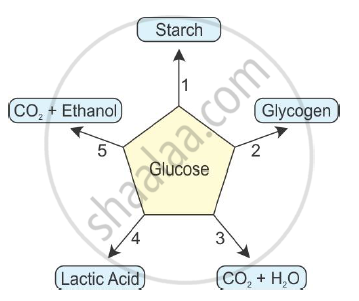Advertisements
Advertisements
Question
With regard to the respiratory system and the process of respiration in man, answer the following question:
What is meant by :
- Residual air and
- Dead air space
Solution
1. Residual air: Some air is always left in the lungs even after forcibly breathing out. This is the leftover or residual air. This volume is 1500 mL.
2. Dead air space: Some tidal air is left in the respiratory passages such as the trachea and bronchi, where no diffusion of gases can occur. This volume is called dead air space. It is 150 mL.
APPEARS IN
RELATED QUESTIONS
State whether the statement is true or false:
Aquatic animals breathe at a slower rate than the terrestrial animals.
Given below are the end products of different reactions involving glucose.

Write the reaction number in front of the following:
(i) Anaerobic reaction =
(ii) Reaction in the human muscles =
(iii) Aerobic respiration =
(iv) Reaction in the plant cells =
(v) Reaction in the liver
How are the lungs designed in human beings to maximize the area for exchange of gases?
The breakdown of pyruvate to give carbon dioxide, water, and energy takes place in ______.
List the differences between aerobic and anaerobic respiration.
Define breathing. State the differences between breathing and respiration.
What is meant by aquatic animals and terrestrial animals?
Explain how, the air we breathe in gets cleaned while passing through the nasal passage.
Describe the exchange of gases which takes place in the leaves of a plant
(a) during daytime, and (b) at night.
"Respiration is a vital function of the body". Justify this statements.
During respiration, the exchange of gases takes place in:
Which of the following is the correct sequence of air passage during inhalation?
(a) nostrils → larynx → pharynx → trachea → lungs
(b) nasal passage → trachea → pharynx → larynx → alveoli
(c) larynx → nostrils → pharynx → lungs
(d) nostrils → pharynx → larynx → trachea → alevoli
During marathon, we sometimes get painful contractions of leg muscles due to the accumulation of one of the following in leg muscles. This is:
There are five animals P, Q, R, S and T. The animal P always lives in water and has gills for breathing. The animal Q can stay in water as well as on land and can breathe both, through moist skin and lungs. The animal R lives in soil and breathes only through its skin. The animal S lives on land and breathes through spiracles and tracheae. And animal T lives in water and breathes through its cell membrane.
(a) Which of the animals could be Amoeba?
(b) Which of the animals could be frog?
(c) Which animal could be fish?
(d) Which animal could be grasshopper?
(e) Which animal could be earthworm?
Answer the following in short.
Define respiration.
Answer the following in detail.
Explain the process of Cellular Respiration.
Choose the odd one out in the following groups of four items each:
Diffusion, Respiratory gases, Alveoli, Capillary network
Choose the odd one out in each of the following groups of four items each:
Oxyhaemoglobin, Carbaminohaemoglobin, Hypoxia, Carboxyhaemoglobin
Name the body structure concerned with the given functional activity:
Prevents food from entering the trachea during swallowing.
Given below is an example of certain structure and its special functional activity:
"Kidney and excretion".
Fill in the blanks on a similar pattern.
Mitochondria and _____________.
Given below is an example of certain structure and its special functional activity:
"Kidney and excretion".
Fill in the blanks on a similar pattern.
'C' shaped cartilage rings and ____________.
State one function of the following:
Diaphragm
Match the items in Column A with those in Column B.
|
Column A |
Column B |
|
Cartilaginous |
Epiglottis |
|
Large surface area |
Diaphragm |
|
Breathing movements |
Bronchi |
|
Voice |
Alveoli |
|
Complemental air |
Larynx |
|
Swallowing |
Extra inhalation |
Given below is an overall chemical reaction of a certain process:
C6H12O6 →LacticAcid+2ATP+Heat energy
Name the process.
What percent of oxygen is transported in a dissolved state by the plasma?
Name the substances whose build-up in the muscles during vigorous physical exercise may cause cramps?
Which of the following statement(s) is (are) true about respiration?
- During inhalation, ribs move inward and the diaphragm is raised
- In the alveoli, exchange of gases takes place i.e., oxygen from alveolar air diffuses into blood and carbon dioxide from the blood into the alveolar air
- Haemoglobin has a greater affinity for carbon dioxide than oxygen
- Alveoli increase surface area for the exchange of gases
Breathing is a process that
- provides O2 to the body.
- breaks down food to release energy.
- helps the body to get rid of CO2.
- produces water in the cells.
Which of the following gives the correct combination of functions of breathing?
